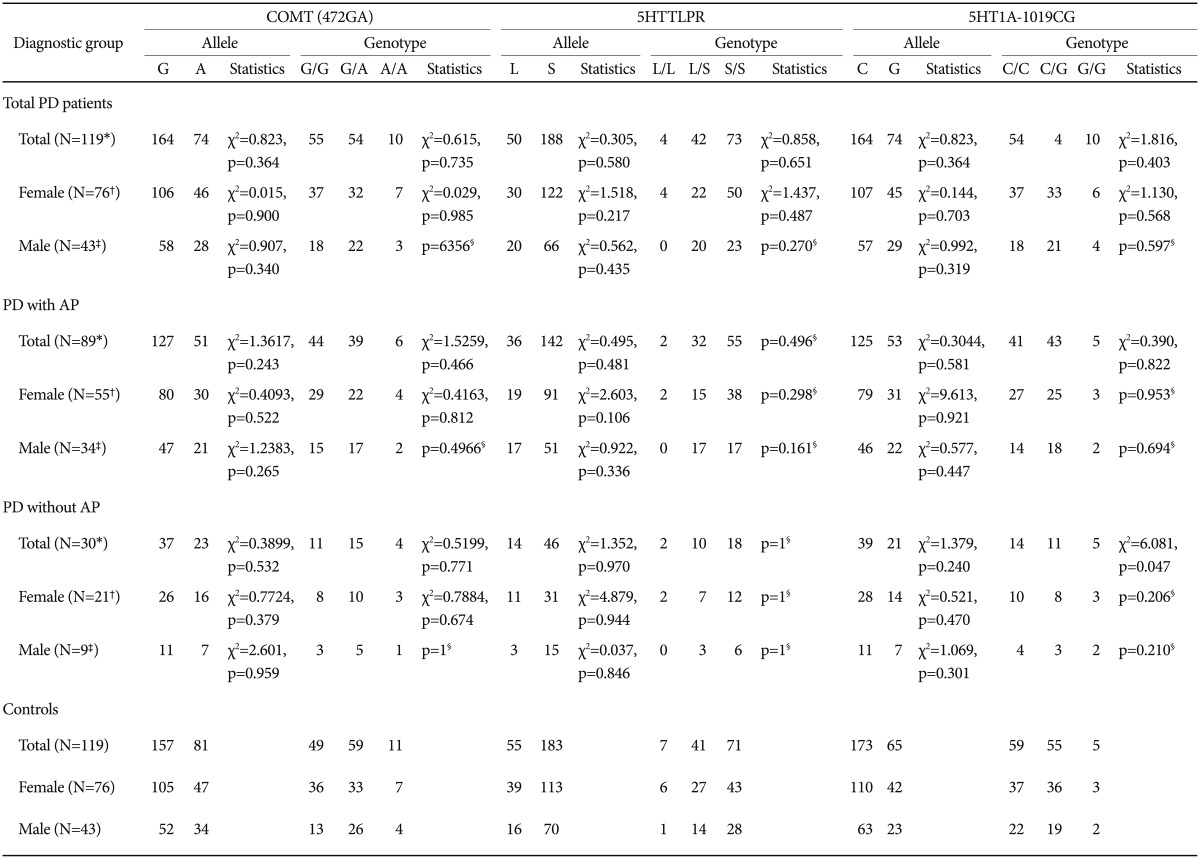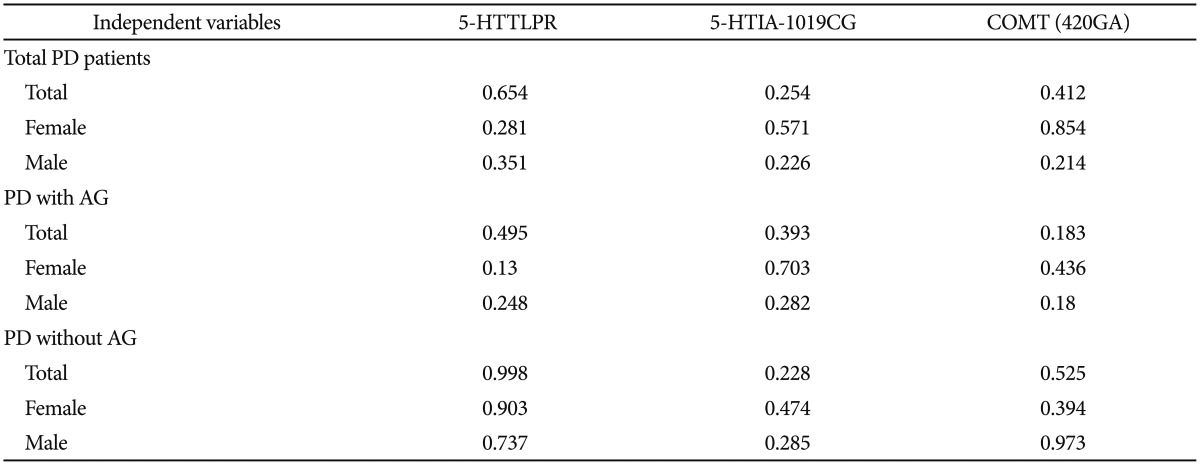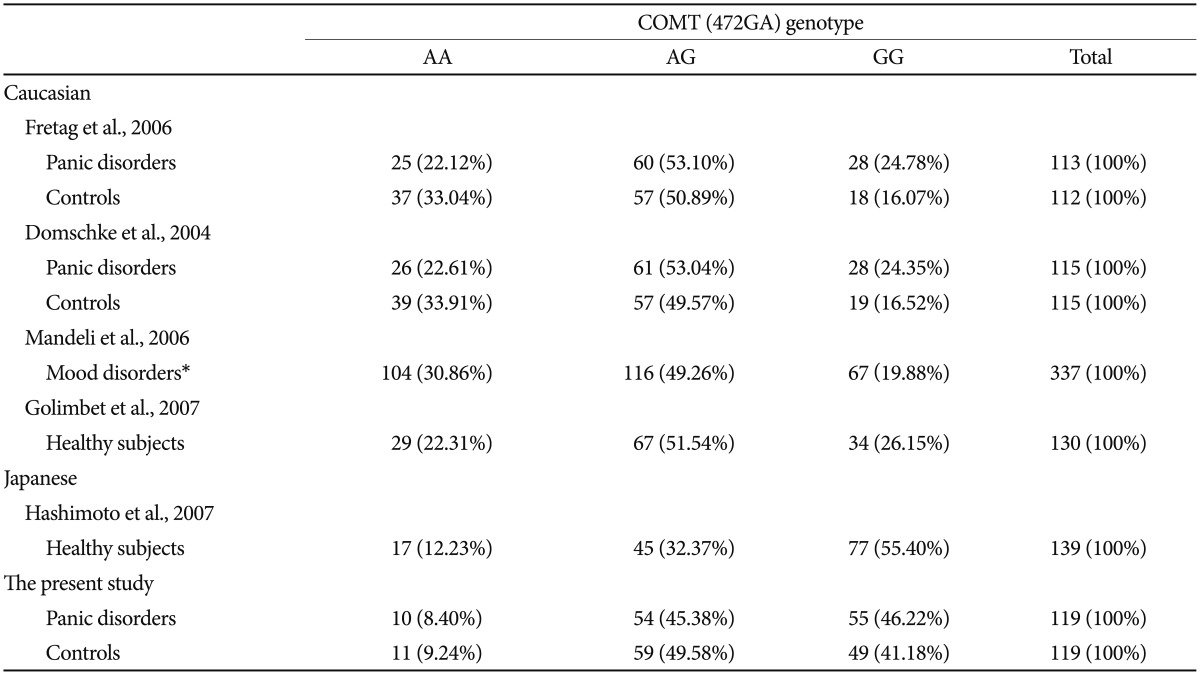1. Kaplan HI, Sadock BJ, Grebb JA. Kaplan and Sadock's Synopsis of Psychiatry: Behavioral Sciences, Clinical Psychiatry. 7th Edition. Baltimore: Williams & Wilkins; 1994.
2. Kessler RC, Chiu WT, Jin R, Ruscio AM, Shear K, Walters EE. The epidemiology of panic attacks, panic disorder, and agoraphobia in the National Comorbidity Survey Replication. Arch Gen Psychiatry 2006;63:415-424. PMID:
16585471.



3. Carlbring P, Gustafsson H, Ekselius L, Andersson G. 12-month prevalence of panic disorder with or without agoraphobia in the Swedish general population. Soc Psychiatry Psychiatr Epidemiol 2002;37:207-211. PMID:
12107711.


4. Crowe RR, Noyes R, Pauls DL, Slymen D. A family study of panic disorder. Arch Gen Psychiatry 1983;40:1065-1069. PMID:
6625855.


5. Harris EL, Noyes R Jr, Crowe RR, Chaudhry DR. Family study of agoraphobia. Report of a pilot study. Arch Gen Psychiatry 1983;40:1061-1064. PMID:
6625854.


6. Skre I, Onstad S, Torgersen S, Lygren S, Kringlen E. A twin study of DSM-III-R anxiety disorders. Acta Psychiatr Scand 1993;88:85-92. PMID:
8213211.


7. Hettema JM, Neale MC, Kendler KS. A review and meta-analysis of the genetic epidemiology of anxiety disorders. Am J Psychiatry 2001;158:1568-1578. PMID:
11578982.


8. Charney DS, Heninger GR, Breier A. Noradrenergic function in panic anxiety. Effects of yohimbine in healthy subjects and patients with agoraphobia and panic disorder. Arch Gen Psychiatry 1984;41:751-763. PMID:
6742977.


9. Ko GN, Elsworth JD, Roth RH, Rifkin BG, Leigh H, Redmond DE Jr. Panic-induced elevation of plasma MHPG levels in phobic-anxious patients. Effects of clonidine and imipramine. Arch Gen Psychiatry 1983;40:425-430. PMID:
6838322.


10. Freitag CM, Domschke K, Rothe C, Lee YJ, Hohoff C, Gutknecht L, et al. Interaction of serotonergic and noradrenergic gene variants in panic disorder. Psychiatr Genet 2006;16:59-65. PMID:
16538182.


11. Lachman HM, Papolos DF, Saito T, Yu YM, Szumlanski CL, Weinshilboum RM. Human catechol-O-methyltransferase pharmacogenetics: description of a functional polymorphism and its potential application to neuropsychiatric disorders. Pharmacogenetics 1996;6:243-250. PMID:
8807664.


12. Chen J, Lipska BK, Halim N, Ma QD, Matsumoto M, Melhem S, et al. Functional analysis of genetic variation in catechol-O-methyltransferase (COMT): effects on mRNA, protein, and enzyme activity in postmortem human brain. Am J Hum Genet 2004;75:807-821. PMID:
15457404.



13. Domschke K, Deckert J, O'Donovan MC, Glatt SJ. Meta-analysis of COMT val158met in panic disorder: ethnic heterogeneity and gender specificity. Am J Med Genet B Neuropsychiatr Genet 2007;144B:667-673. PMID:
17357147.


14. Heils A, Teufel A, Petri S, Stober G, Riederer P, Bengel D, et al. Allelic variation of human serotonin transporter gene expression. J Neurochem 1996;66:2621-2624. PMID:
8632190.


15. Deckert J, Catalano M, Heils A, Di Bella D, Friess F, Politi E, et al. Functional promoter polymorphism of the human serotonin transporter: lack of association with panic disorder. Psychiatr Genet 1997;7:45-47. PMID:
9264139.


16. Hamilton SP, Heiman GA, Haghighi F, Mick S, Klein DF, Hodge SE, et al. Lack of genetic linkage or association between a functional serotonin transporter polymorphism and panic disorder. Psychiatr Genet 1999;9:1-6. PMID:
10335545.


17. Ishiguro H, Arinami T, Yamada K, Otsuka Y, Toru M, Shibuya H. An association study between a transcriptional polymorphism in the serotonin transporter gene and panic disorder in a Japanese population. Psychiatry Clin Neurosci 1997;51:333-335. PMID:
9413883.


18. Olesen OF, Bennike B, Hansen ES, Koefoed P, Woldbye DP, Bolwig TG, et al. The short/long polymorphism in the serotonin transporter gene promoter is not associated with panic disorder in a Scandinavian sample. Psychiatr Genet 2005;15:159PMID:
16094247.


19. Blaya C, Salum GA, Lima MS, Leistner-Segal S, Manfro GG. Lack of association between the Serotonin Transporter Promoter Polymorphism (5-HTTLPR) and Panic Disorder: a systematic review and meta-analysis. Behav Brain Funct 2007;3:41PMID:
17705872.



20. Le Francois B, Czesak M, Steubl D, Albert PR. Transcriptional regulation at a HTR1A polymorphism associated with mental illness. Neuropharmacology 2008;55:977-985. PMID:
18639564.


21. Rothe C, Gutknecht L, Freitag C, Tauber R, Mossner R, Franke P, et al. Association of a functional 1019C>G 5-HT1A receptor gene polymorphism with panic disorder with agoraphobia. Int J Neuropsychopharmacol 2004;7:189-192. PMID:
14984628.


22. Neumeister A, Bain E, Nugent AC, Carson RE, Bonne O, Luckenbaugh DA, et al. Reduced serotonin type 1A receptor binding in panic disorder. J Neurosci 2004;24:589-591. PMID:
14736842.



23. David SP, Murthy NV, Rabiner EA, Munafo MR, Johnstone EC, Jacob R, et al. A functional genetic variation of the serotonin (5-HT) transporter affects 5-HT1A receptor binding in humans. J Neurosci 2005;25:2586-2590. PMID:
15758168.



24. Lesch KP, Bengel D, Heils A, Sabol SZ, Greenberg BD, Petri S, et al. Association of anxiety-related traits with a polymorphism in the serotonin transporter gene regulatory region. Science 1996;274:1527-1531. PMID:
8929413.


25. Domschke K, Freitag CM, Kuhlenbaumer G, Schirmacher A, Sand P, Nyhuis P, et al. Association of the functional V158M catechol-O-methyl-transferase polymorphism with panic disorder in women. Int J Neuropsychopharmacol 2004;7:183-188. PMID:
15009906.


26. Baraban JM, Aghajanian GK. Suppression of firing activity of 5-HT neurons in the dorsal raphe by alpha-adrenoceptor antagonists. Neuropharmacology 1980;19:355-363. PMID:
6104308.


27. Lemonde S, Turecki G, Bakish D, Du L, Hrdina PD, Bown CD, et al. Impaired repression at a 5-hydroxytryptamine 1A receptor gene polymorphism associated with major depression and suicide. J Neurosci 2003;23:8788-8799. PMID:
14507979.



28. Golimbet VE, Alfimova MV, Gritsenko IK, Ebstein RP. Relationship between dopamine system genes and extraversion and novelty seeking. Neurosci Behav Physiol 2007;37:601-606. PMID:
17657431.


29. Hashimoto R, Noguchi H, Hori H, Ohi K, Yasuda Y, Takeda M, et al. A possible association between the Val158Met polymorphism of the catechol-O-methyl transferase gene and the personality trait of harm avoidance in Japanese healthy subjects. Neurosci Lett 2007;428:17-20. PMID:
17945417.


30. Reif A, Weber H, Domschke K, Klauke B, Baumann C, Jacob CP, et al. Meta-analysis argues for a female-specific role of MAOA-uVNTR in panic disorder in four European populations. Am J Med Genet B Neuropsychiatr Genet 2012;159b:786-793. PMID:
22911667.


31. Bandelow B, Saleh K, Pauls J, Domschke K, Wedekind D, Falkai P. Insertion/deletion polymorphism in the gene for angiotensin converting enzyme (ACE) in panic disorder: A gender-specific effect? World J Biol Psychiatry 2010;11:66-70. PMID:
20146651.


32. Olsson M, Annerbrink K, Westberg L, Melke J, Baghaei F, Rosmond R, et al. Angiotensin-related genes in patients with panic disorder. Am J Med Genet B Neuropsychiatr Genet 2004;127b:81-84. PMID:
15108186.


33. Shimizu E, Hashimoto K, Kobayashi K, Mitsumori M, Ohgake S, Koizumi H, et al. Lack of association between angiotensin I-converting enzyme insertion/deletion gene functional polymorphism and panic disorder in humans. Neurosci Lett 2004;363:81-83. PMID:
15158002.


34. Inada Y, Yoneda H, Koh J, Sakai J, Himei A, Kinoshita Y, et al. Positive association between panic disorder and polymorphism of the serotonin 2A receptor gene. Psychiatry Res 2003;118:25-31. PMID:
12759158.














